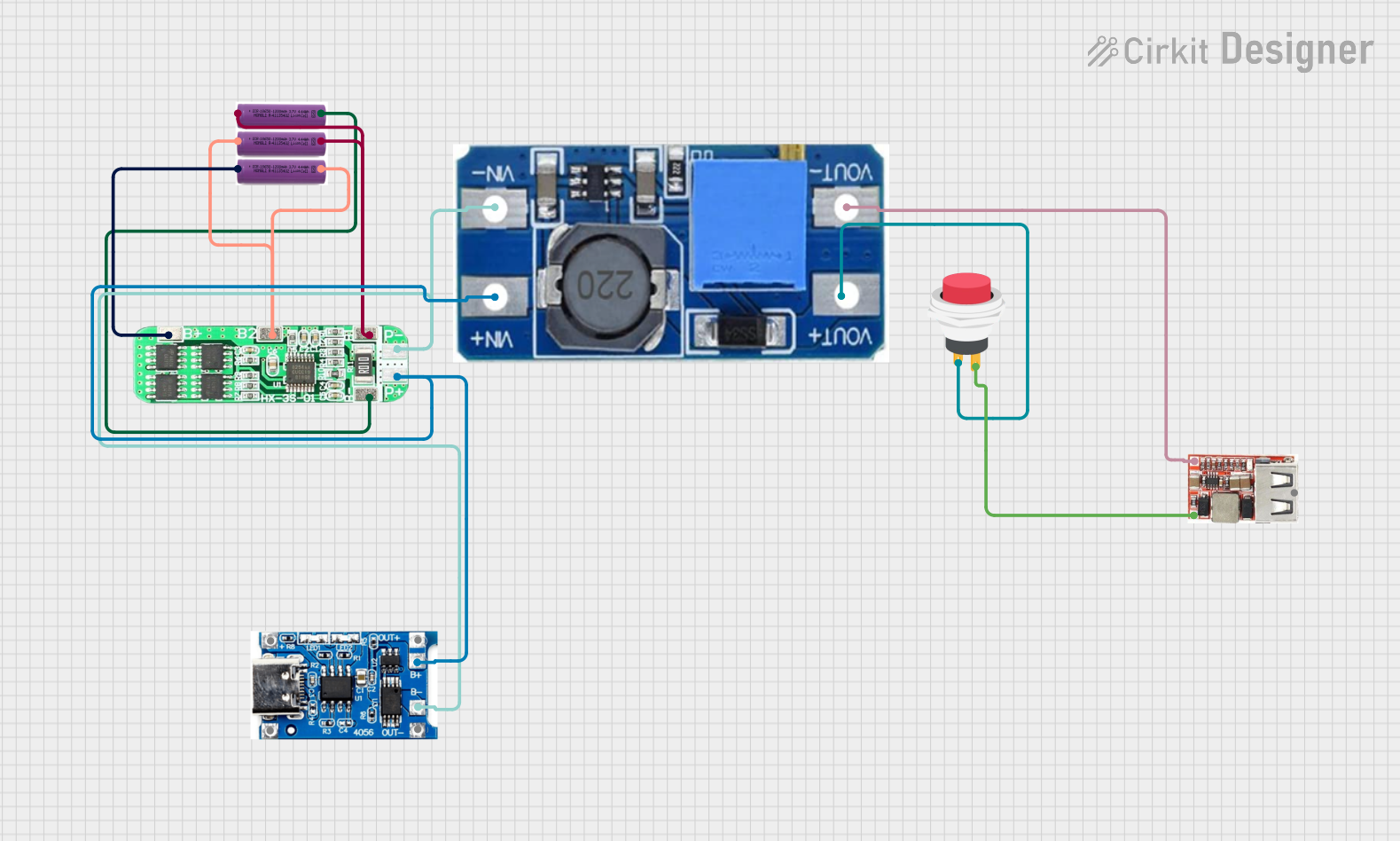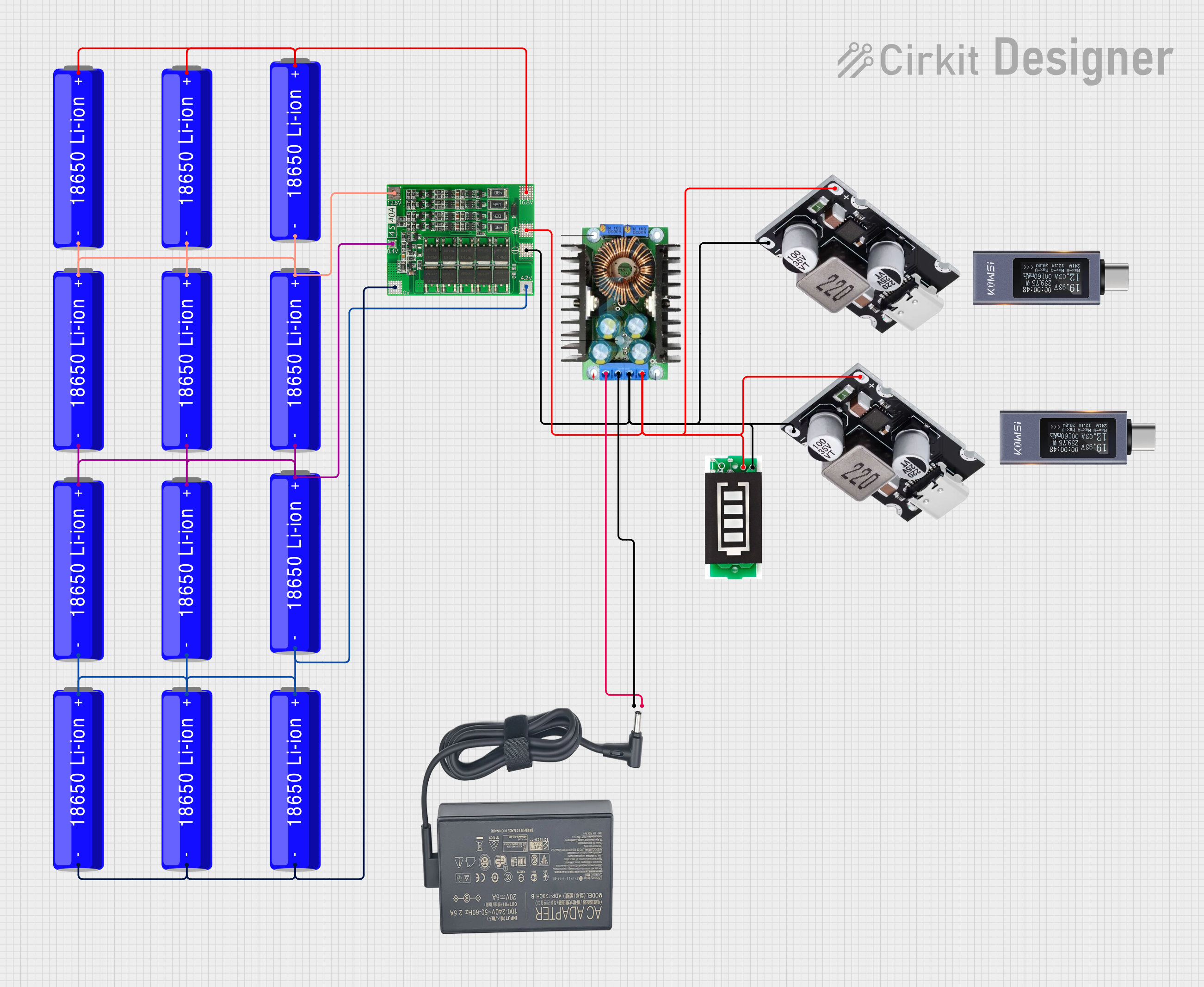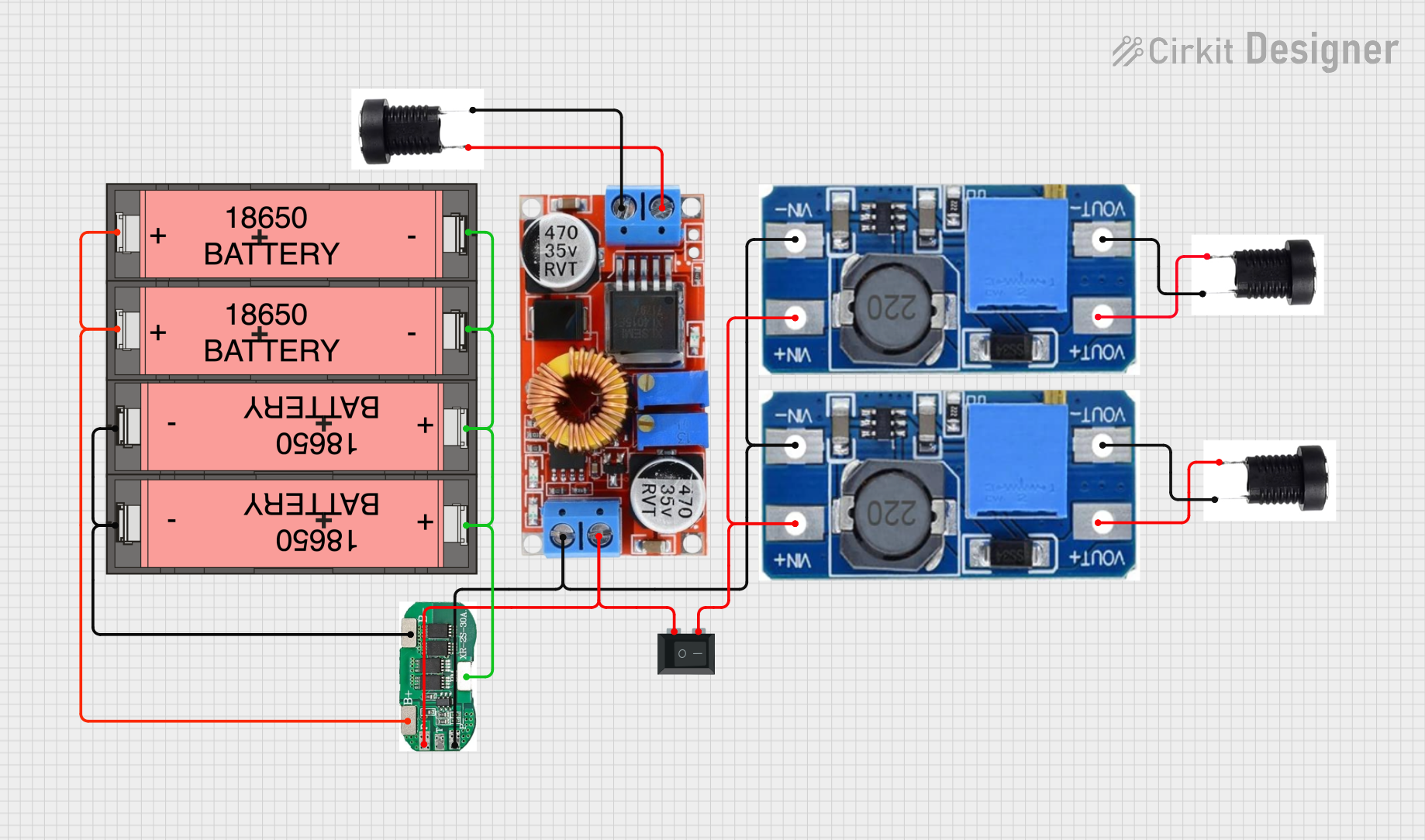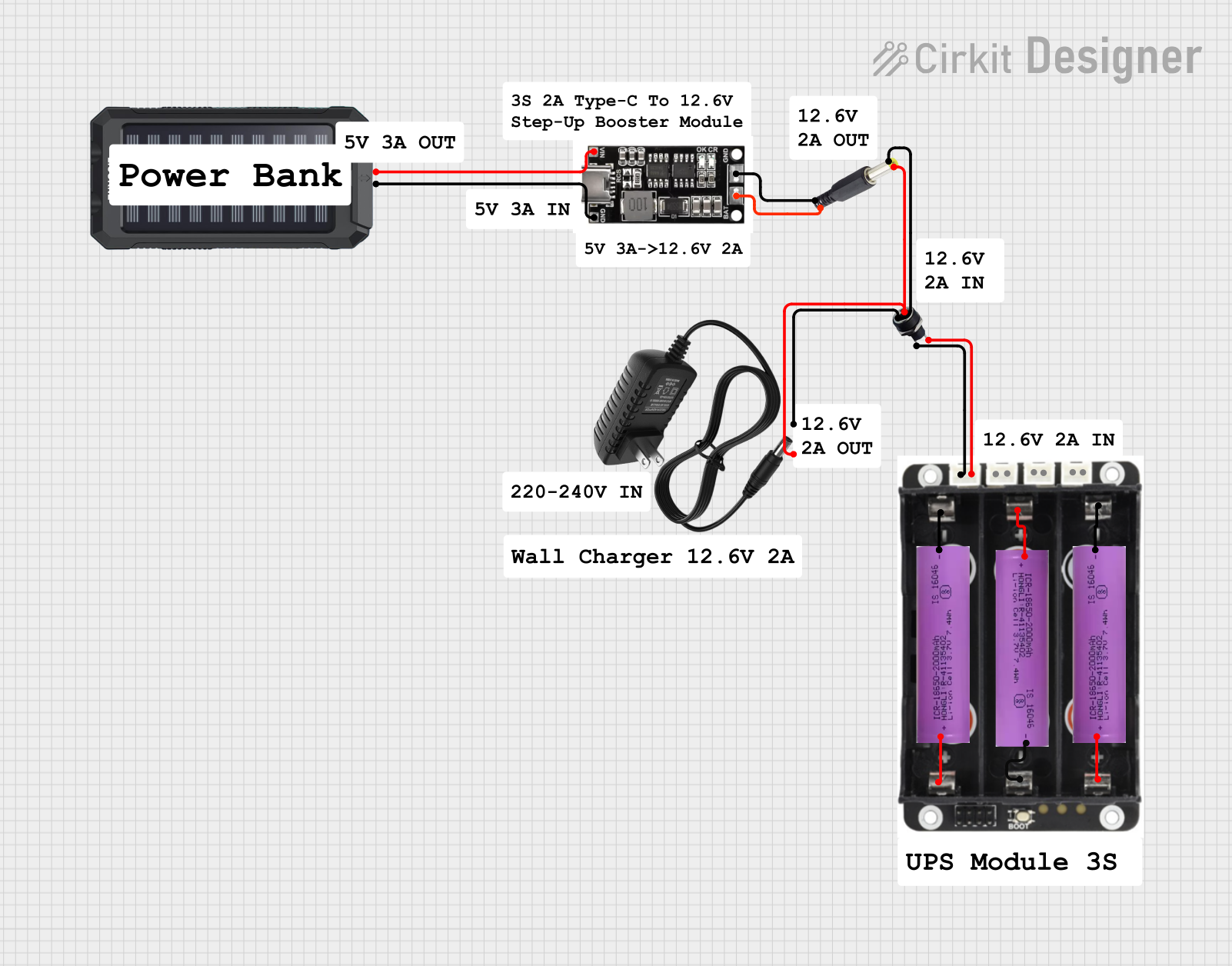
How to Use Li-ion battery 18650-2000mAh 3.7V 7.4WH: Examples, Pinouts, and Specs

 Design with Li-ion battery 18650-2000mAh 3.7V 7.4WH in Cirkit Designer
Design with Li-ion battery 18650-2000mAh 3.7V 7.4WH in Cirkit DesignerIntroduction
The 18650-2000mAh 3.7V 7.4Wh is a cylindrical rechargeable lithium-ion battery that is widely used in portable electronics, power tools, and electric vehicles. Its high energy density, long life cycle, and relatively stable voltage output make it a popular choice for projects that require a compact, reliable power source.
Explore Projects Built with Li-ion battery 18650-2000mAh 3.7V 7.4WH

 Open Project in Cirkit Designer
Open Project in Cirkit Designer
 Open Project in Cirkit Designer
Open Project in Cirkit Designer
 Open Project in Cirkit Designer
Open Project in Cirkit Designer
 Open Project in Cirkit Designer
Open Project in Cirkit DesignerExplore Projects Built with Li-ion battery 18650-2000mAh 3.7V 7.4WH

 Open Project in Cirkit Designer
Open Project in Cirkit Designer
 Open Project in Cirkit Designer
Open Project in Cirkit Designer
 Open Project in Cirkit Designer
Open Project in Cirkit Designer
 Open Project in Cirkit Designer
Open Project in Cirkit DesignerCommon Applications and Use Cases
- Portable electronics (flashlights, cameras)
- Power banks
- Electric vehicles (e-bikes, scooters)
- DIY electronics projects
- Backup power supplies
Technical Specifications
Key Technical Details
| Parameter | Value |
|---|---|
| Chemistry | Li-ion |
| Nominal Voltage | 3.7V |
| Capacity | 2000mAh |
| Energy | 7.4Wh |
| Charge Voltage | 4.2V |
| Discharge Cut-off | 2.5V |
| Standard Charge | 0.2C (400mA) |
| Max Charge Current | 1C (2000mA) |
| Max Discharge Rate | 2C (4000mA) |
| Operating Temp. | Charge: 0°C to 45°C, Discharge: -20°C to 60°C |
Pin Configuration and Descriptions
Since the 18650-2000mAh battery is a single cell, it does not have a traditional pin configuration. Instead, it has a positive terminal (cathode) and a negative terminal (anode).
| Terminal | Description |
|---|---|
| Positive | Cathode (+) |
| Negative | Anode (-) |
Usage Instructions
How to Use the Component in a Circuit
- Battery Holder: Use a compatible 18650 battery holder or a dedicated compartment to securely place the battery.
- Connections: Ensure the positive terminal of the battery is connected to the positive input of your circuit and the negative terminal to the negative input.
- Charging Circuit: Incorporate a charging circuit designed for Li-ion batteries to safely charge the battery.
- Protection Circuit: It is highly recommended to use a protection circuit module (PCM) to prevent overcharging, deep discharging, and short-circuiting.
Important Considerations and Best Practices
- Charging: Never exceed the recommended charge voltage of 4.2V and charge current of 1C (2000mA).
- Discharging: Do not discharge the battery below its cut-off voltage of 2.5V to prevent damage.
- Temperature: Operate and charge the battery within the specified temperature ranges.
- Storage: Store the battery at half-charge in a cool, dry place if not in use for extended periods.
- Handling: Avoid puncturing, crushing, or exposing the battery to water and fire.
Troubleshooting and FAQs
Common Issues
- Battery won't charge: Ensure the charger is functioning and the contacts are clean. Check if the PCM is not in a protection state.
- Reduced capacity: Over time and with use, the battery capacity will diminish. This is normal for Li-ion batteries.
- No output voltage: The battery may be deeply discharged or the PCM may have triggered protection. Try recharging the battery.
Solutions and Tips for Troubleshooting
- Charging Issues: Verify the charger specifications match the battery requirements. If the PCM has triggered, disconnect and reconnect the battery to reset it.
- Capacity Issues: If the battery capacity is significantly reduced, consider replacing the battery.
- Voltage Issues: If there is no output voltage after attempting to charge, the battery may be damaged and should be replaced.
FAQs
Q: Can I charge the 18650 battery with a standard USB charger? A: No, you should use a charger specifically designed for Li-ion batteries with the correct voltage and current ratings.
Q: How do I know when the battery is fully charged? A: A dedicated Li-ion battery charger will typically indicate when the battery is fully charged. The voltage should not exceed 4.2V.
Q: Is it safe to leave the battery charging overnight? A: It is not recommended to leave Li-ion batteries charging unattended unless you are using a charger with an appropriate safety cutoff.
Q: Can I use multiple 18650 batteries in series or parallel? A: Yes, but it is crucial to match the batteries in terms of capacity, state of charge, and age to prevent imbalance. Always use a protection circuit.
Q: How long does it take to charge the battery? A: Charging time depends on the charger's current output. With a standard charge current of 400mA, it would take approximately 5 hours to charge fully.
Q: Can I replace NiMH or NiCd batteries with this Li-ion battery? A: Li-ion batteries have different voltage and charging requirements. You must ensure the device is compatible with Li-ion chemistry and adjust the circuit accordingly.
Q: What should I do if the battery gets hot during use or charging? A: Stop using or charging the battery immediately and place it in a safe area away from flammable materials. Overheating may indicate a malfunction or short-circuit.
Conclusion
The 18650-2000mAh 3.7V 7.4Wh Li-ion battery is a versatile and reliable power source for various applications. Proper usage and care are essential to ensure safety and longevity. Always follow the manufacturer's guidelines and use dedicated charging and protection circuits designed for Li-ion batteries.